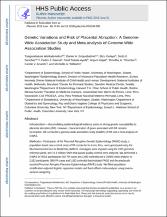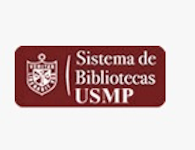Mostrar el registro sencillo del ítem
Genetic variations and risk of placental abruption: a genome-wide association study and meta-analysis of genome-wide association studies
| dc.contributor.author | Workalemahu, Tsegaselassie | |
| dc.contributor.author | Enquobahrie, Daniel A. | |
| dc.contributor.author | Gelaye, Bizu | |
| dc.contributor.author | Sanchez, Sixto E. | |
| dc.contributor.author | Garcia, Pedro J. | |
| dc.contributor.author | Tekola-Ayele, Fasil | |
| dc.contributor.author | Hajat, Anjum | |
| dc.contributor.author | Thornton, Timothy A. | |
| dc.contributor.author | Ananth, Cande V. | |
| dc.contributor.author | Williams, Michelle A. | |
| dc.date.accessioned | 2020-05-29T15:43:10Z | |
| dc.date.available | 2020-05-29T15:43:10Z | |
| dc.date.issued | 2018-04-16 | |
| dc.identifier.citation | Workalemahu T., Enquobahrie DA., Gelaye B., Sanchez SE., Garcia PJ., Tekola-Ayele F., et al. Genetic variations and risk of placental abruption: A genome-wide association study and meta-analysis of genome-wide association studies. Placenta. 2018;66:8-16. | es_PE |
| dc.identifier.uri | https://hdl.handle.net/20.500.12727/6120 | |
| dc.description.abstract | Introduction Accumulating epidemiological evidence points to strong genetic susceptibility to placental abruption (PA). However, characterization of genes associated with PA remains incomplete. We conducted a genome-wide association study (GWAS) of PA and a meta-analysis of GWAS. Methods Participants of the Placental Abruption Genetic Epidemiology (PAGE) study, a population based case-control study of PA conducted in Lima, Peru, were genotyped using the Illumina HumanCore-24 BeadChip platform. Genotypes were imputed using the 1000 genomes reference panel, and >4.9 million SNPs that passed quality control were analyzed. We performed a GWAS in PAGE participants (507 PA cases and 1090 controls) and a GWAS meta-analysis in 2512 participants (959 PA cases and 1553 controls) that included PAGE and the previously reported Peruvian Abruptio Placentae Epidemiology (PAPE) study. We fitted population stratification-adjusted logistic regression models and fixed-effects meta-analyses using inverse-variance weighting. Results Independent loci (linkage-disequilibrium<0.80) suggestively associated with PA (P-value<5e-5) included rs4148646 and rs2074311 in ABCC8, rs7249210, rs7250184, rs7249100 and rs10401828 in ZNF28, rs11133659 in CTNND2, and rs2074314 and rs35271178 near KCNJ11 in the PAGE GWAS. Similarly, independent loci suggestively associated with PA in the GWAS meta-analysis included rs76258369 near IRX1, and rs7094759 and rs12264492 in ADAM12. Functional analyses of these genes showed trophoblast-like cell interaction, as well as networks involved in endocrine system disorders, cardiovascular diseases, and cellular function. Conclusions We identified several genetic loci and related functions that may play a role in PA risk. Understanding genetic factors underlying pathophysiological mechanisms of PA may facilitate prevention and early diagnostic efforts. | es_PE |
| dc.format.extent | pp. 8-16 | es_PE |
| dc.language.iso | eng | es_PE |
| dc.publisher | Elsevier Ltd. | es_PE |
| dc.relation.ispartof | urn:issn:1690-4648 | |
| dc.relation.ispartofseries | Placenta;vol. 66 | |
| dc.relation.uri | https://www.ncbi.nlm.nih.gov/pmc/articles/PMC5995331/ | es_PE |
| dc.relation.uri | https://doi.org/10.1016/j.placenta.2018.04.008 | es_PE |
| dc.rights | info:eu-repo/semantics/openAccess | es_PE |
| dc.rights.uri | https://creativecommons.org/licenses/by-nc-nd/4.0/ | es_PE |
| dc.source | Repositorio Académico USMP | es_PE |
| dc.source | Universidad San Martín de Porres - USMP | es_PE |
| dc.subject | Desprendimiento prematuro de la placenta | es_PE |
| dc.subject | Estudio de asociación del genoma completo | es_PE |
| dc.subject | Metaanálisis | es_PE |
| dc.title | Genetic variations and risk of placental abruption: a genome-wide association study and meta-analysis of genome-wide association studies | es_PE |
| dc.type | info:eu-repo/semantics/article | es_PE |
| thesis.degree.name | Medicina Humana | es_PE |
| thesis.degree.grantor | Universidad de San Martín de Porres. Facultad de Medicina Humana | es_PE |
| thesis.degree.discipline | Medicina | es_PE |
| dc.subject.ocde | https://purl.org/pe-repo/ocde/ford#3.02.00 | es_PE |
Ficheros en el ítem
Este ítem aparece en la(s) siguiente(s) colección(es)
-
Artículos [274]








